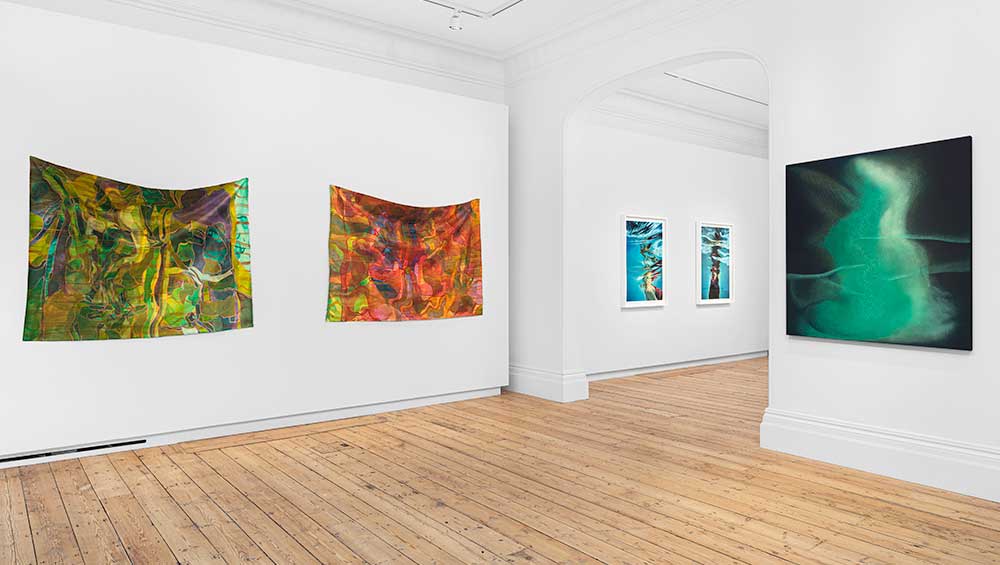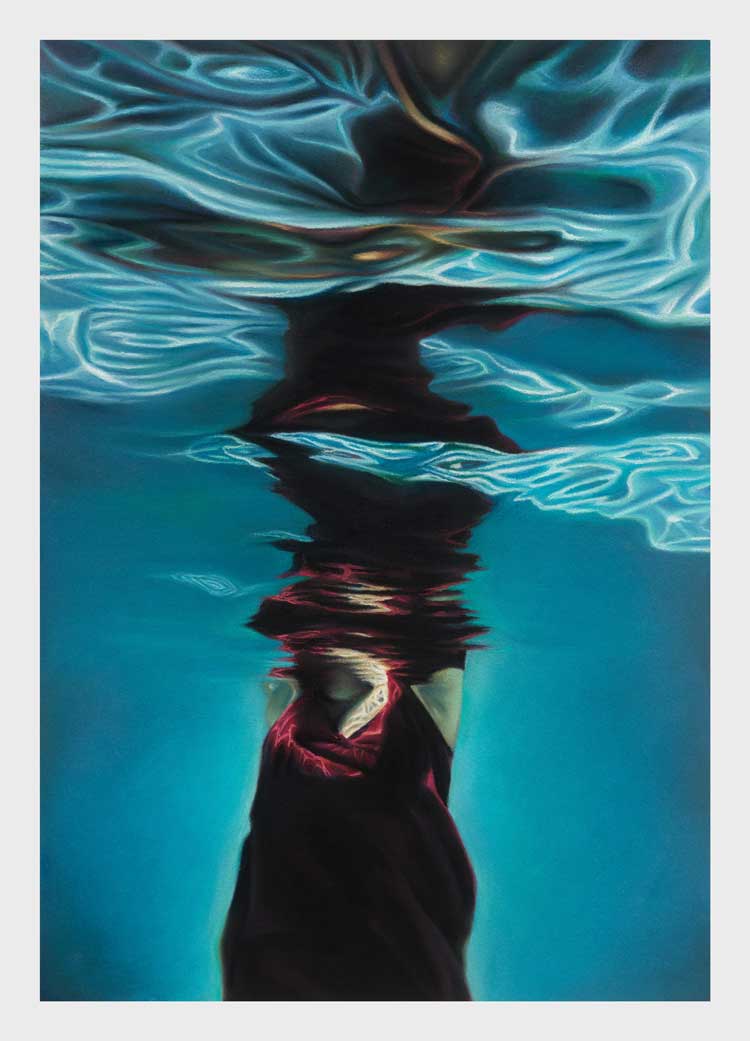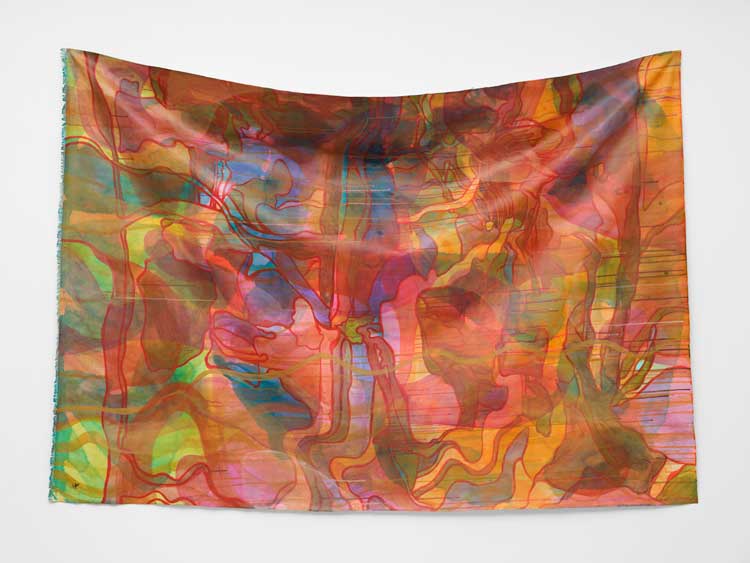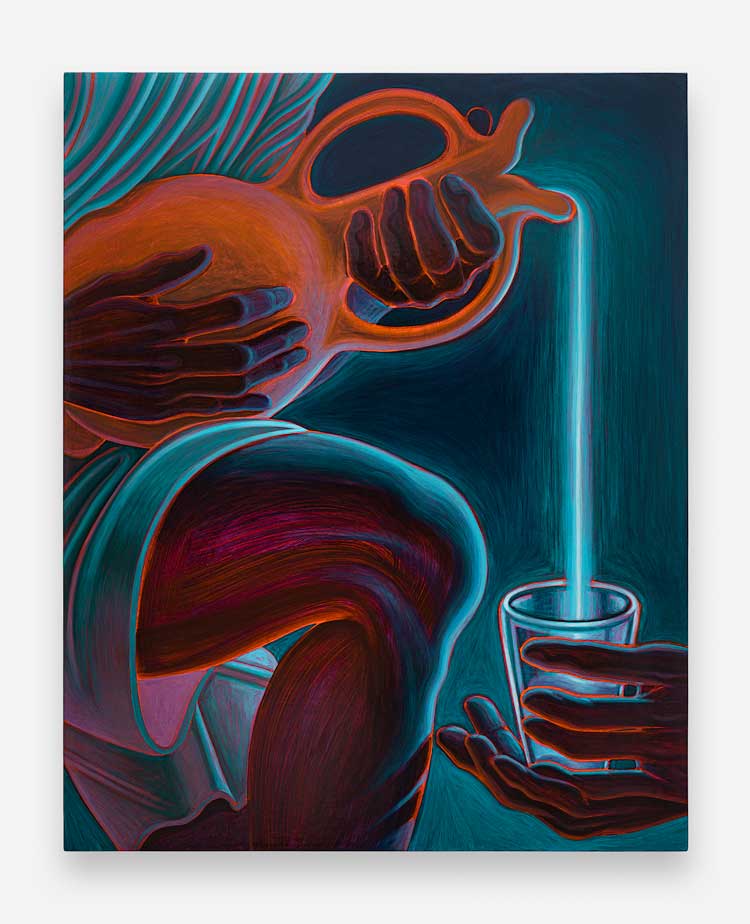
Beneath the Surface, installation view, Lehmann Maupin, London, 2023. Photo: Eva Herzog.
Lehmann Maupin, London
18 January – 4 March 2023
by VERONICA SIMPSON
Beneath the Surface is a show about water, but it uses this medium of refreshment and hydration as a lens through which multiple perspectives on history, culture and identity can be viewed. Foregrounding black culture and history – though not exclusively - it is curated by Lehmann Maupin’s London senior director, Isabella Icoz, who has cherry-picked work from six artists, some represented by the gallery but some not, to interrogate issues of trade, slavery, oppression, servitude, exclusion and inclusion. Here is a rich smörgåsbord of textures, issues, perspectives and techniques from across the globe and the last century: Heidi Bucher (1926-93, Switzerland), Alex Gardner (b1987, US), Lubaina Himid (b1954, Zanzibar), Shirazeh Houshiary (b1955, Iran), Araba Opoku (b1998, Accra, Ghana) and Calida Rawles (b1976, US).
-install-Shirazeh-Houshiary-Styx-(2018).jpg)
Shirazeh Houshiary. Styx, 2018. Pigment, pencil, and white aquacryl on canvas and aluminium, 74.8 x 74.8 in. Courtesy the artist and Lehmann Maupin, New York, Hong Kong, Seoul, and London.
There are works that do conjure water’s more immediate, splashy textures. Take Houshiary’s Styx (2018). It is a Rorschach blot of red, splitting the white of the canvas dead centre, bleeding outwards across its adjacent expanses; you cannot avoid the associations with bloodstains - sanitary towels possibly - definitely leakage of vital fluids. As Icoz says, for Houshiary: “Water is very much the beginning or reference point for all her work. She mixes pigmented water and almost floods the canvas, then washes the canvas, and what you’re seeing is the residue of pigment.” These traces of pigment have double or triple meanings, evoking not just what is present but what has been washed away, linking to memory, history, cultural practices. As with all her work, it repays closer, more patient inspection. Here, at the crimson heart of the painting, she has written in tiny Arabic script a labyrinth of letters spelling out the words “I am. I am not”, over and over, triggering references to blood’s vital presence at birth and death; not to mention issues of whose is spilled and when and how.
-Calida-Rawles.jpg)
Beneath the Surface, installation view, Lehmann Maupin, London, 2023. Works by Calida Rawles. Photo: Eva Herzog.
On the opposite wall are two even more literal representations, by Rawles: this time, two bodies immersed in a sun-drenched pool, the voluptuous rippling effect of sunlight on the water distorting the contours of these clearly female bodies, articulating with almost photographic clarity and accuracy, water’s gorgeous distortions. This is part of a body of work by Rawles, an African American artist based in Los Angeles, evoking the US’s very recent history of segregation. Her generation, and those before, were denied access to America’s public swimming pools, so many of her family and friends never learned to swim. These new works see her documenting some of her friends’ and family’s first immersions into pools.

Calida Rawles. Atomic Will, 2022. Pastel on paper, 28 x 40 in (artwork). Courtesy the artist and Lehmann Maupin, New York, Hong Kong, Seoul, and London. Photo by Eva Herzog.
Rawles’ pastel technique is astonishing, giving these images a quality of lush Kodachrome photographs, but the shaping of the bodies and the focus on the woman’s red swimwear also has significance. They were painted at the time of last year’s shocking vote by the US supreme court to overturn Roe v Wade and, with it, women’s legal right to abortion. Armed with that knowledge, the bodies (especially that in Atomic Will, 2022) become more like unbirthed humans, suspended – imprisoned, even - in a cool, blue, amniotic fluid. As Icoz says: “She is taking these ideas of exclusion and widening the dialogue and conversation to what’s happening today in America.”
Lush, flowing landscapes by the young Ghanaian artist Opuku adorn the adjacent room. Her rippling and vibrantly coloured paintings, semi-figurative, semi-abstract, are apparently inspired by issues of access to safe drinking water, which in northern Ghana – as in most of sub-Saharan Africa – is a huge problem; an estimated 800,000 inhabitants of Ghana only have access to bacteria-laden drinking water, according to the not-for-profit organisation Ceres.

Araba Opoku. Charons Furnace, 2022. Acrylic on canvas, 67.32 x 46.85 in. Courtesy the artist and Lehmann Maupin, New York, Hong Kong, Seoul, and London. Photo by Eva Herzog.
The palette Opuku uses, however, initially seems joyous. Certainly Charons Furnace (2022) is, filled with orange, blue, purple, yellow and gold overlapping forms that could be plants, insects, landscapes or people. She paints directly on to textile and then likes the textile to hang off the wall, a little like a curtain, also mimicking the pooling and fluidity of water. Other of her mesmerising works evoke different emotions: one majoring on rich, bruised colours in purples, pinks and ochre, the other a moody collage of olive and brown.
-01-hr.jpg)
Lubaina Himid. Venetian Maps (Kings), 1997. Acrylic on canvas, 60.04 x 84.06 in. Courtesy the artist and Lehmann Maupin, New York, Hong Kong, Seoul, and London. Photo by Eva Herzog.
Himid’s three works on show here make a strong, graphic counterpart to these more fluid, aquiferous wall-mates. All are taken from her series Venetian Maps, started more than 20 years ago. As Icoz says: “She imagines the city’s canals as repositories of its secrets; their murky waters conceal lost or forgotten objects and bear witness to countless historical narratives – as well as the pollution and erosion caused by climate change and boat traffic.” In the 1977 work Venetian Maps (Kings), Himid places four African leaders, in the form of playing card kings in the canal. In the other two paintings, simple boat forms are topped with structures symbolic of conquering and oppressing, equally evocative of state and church.
-Alex-Gardner.jpg)
Beneath the Surface, installation view, Lehmann Maupin, London, 2023. Works by Alex Gardner. Photo: Eva Herzog.
There are two works by Gardner, who is based in Los Angeles and has never shown before in the UK. Responding to the theme of What Lies Beneath, his works deliver an ancient take on his typically quite classic portraiture style: something redolent of Greek and Roman friezes. A muscular black arm is proffering a vessel in one, wearing a garment somewhere between a T-shirt and a toga, as another hand reaches out to take it.

Alex Gardner. Nurturing Dependence, 2022. Acrylic on canvas, 30 x 24 in. Courtesy the artist and Lehmann Maupin, New York, Hong Kong, Seoul, and London. Photo by Eva Herzog.
In another, a muscular knee is bent (in a gesture of supplication?) while the owner’s strong, black hands pour an iridescent stream of water from a vessel into a glass held by another pair of hands. Its title, Nurturing Dependence (2022), adds extra cultural resonance to this timeless image.

Heidi Bucher. Untitled (Wasserzeichnung / Water drawing), 1985. Watercolor on paper, 22.05 x 16.54 in. © The Estate of Heidi Bucher. Courtesy the artist and Lehmann Maupin, New York, Hong Kong, Seoul, and London. Photo by Eva Herzog.
The only artist who doesn’t fit into these post-colonial cultural contexts – and the only white European in the mix - is Bucher. Best known for her architectural mouldings as explorations and representations of the body in space, she has here been meditating on water, as a series of bold, single-stroke watercolours framed in the gallery’s office and a sculptural work of water spilling out of a vessel, demonstrate.

Shirazeh Houshiary. Valence, 2022. Pigment and pencil on black aquacryl on canvas and aluminium, 47.24 x 47.24 in. Courtesy the artist and Lehmann Maupin, New York, Hong Kong, Seoul, and London. Photo by Eva Herzog.
If I could take one of these works away with me, it would be Valence (2022), a new painting made for this show by Houshiary. At first, it seems simple enough, a geometric vortex of forest green shadowed by dark, black acrylic. What gives it extra intensity and momentum, however, is the way Houshiary has built up this picture in slow, meditative pencil lines, stitched together, in places, by that almost invisible Arabic script. Icoz says: “Something she has incorporated in her practice recently is the idea of water and memory … like a riverbed, the water almost has an idea of what came before it and what goes after; it seems natural but actually it has a memory.”
While to some this notion may seem far-fetched, I would happily meditate on this possibility while allowing my gaze to rest on the endlessly shifting layers, planes and dual colourings of this work. There is truly a lot going on here, “beneath the surface”.